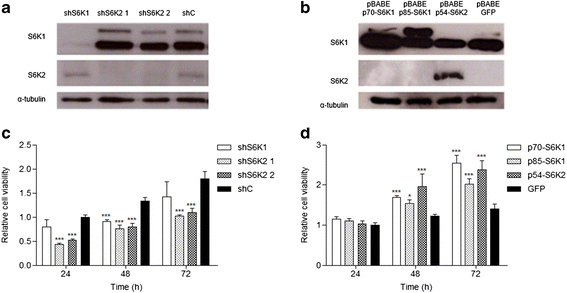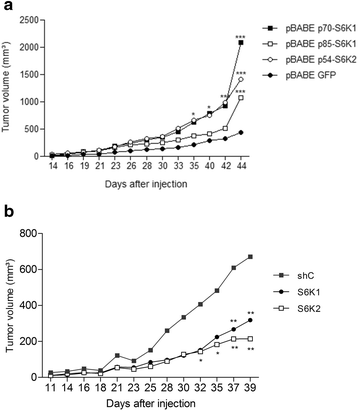S6Ks isoforms contribute to viability, migration, docetaxel resistance and tumor formation of prostate cancer cells
- PMID: 27491285
- PMCID: PMC4974797
- DOI: 10.1186/s12885-016-2629-y
S6Ks isoforms contribute to viability, migration, docetaxel resistance and tumor formation of prostate cancer cells
Abstract
Background: The S6 Kinase (S6K) proteins are some of the main downstream effectors of the mammalian Target Of Rapamycin (mTOR) and act as key regulators of protein synthesis and cell growth. S6K is overexpressed in a variety of human tumors and is correlated to poor prognosis in prostate cancer. Due to the current urgency to identify factors involved in prostate cancer progression, we aimed to reveal the cellular functions of three S6K isoforms-p70-S6K1, p85-S6K1 and p54-S6K2-in prostate cancer, as well as their potential as therapeutic targets.
Methods: In this study we performed S6K knockdown and overexpression and investigated its role in prostate cancer cell proliferation, colony formation, viability, migration and resistance to docetaxel treatment. In addition, we measured tumor growth in Nude mice injected with PC3 cells overexpressing S6K isoforms and tested the efficacy of a new available S6K1 inhibitor in vitro.
Results: S6Ks overexpression enhanced PC3-luc cell line viability, migration, resistance to docetaxel and tumor formation in Nude mice. Only S6K2 knockdown rendered prostate cancer cells more sensitive to docetaxel. S6K1 inhibitor PF-4708671 was particularly effective for reducing migration and proliferation of PC3 cell line.
Conclusions: These findings demonstrate that S6Ks play an important role in prostate cancer progression, enhancing cell viability, migration and chemotherapy resistance, and place both S6K1 and S6K2 as a potential targets in advanced prostate cancer. We also provide evidence that S6K1 inhibitor PF-4708671 may be considered as a potential drug for prostate cancer treatment.
Keywords: Cancer; S6K; mTOR.
Figures





Similar articles
-
Everolimus (RAD001) sensitizes prostate cancer cells to docetaxel by down-regulation of HIF-1α and sphingosine kinase 1.Oncotarget. 2016 Dec 6;7(49):80943-80956. doi: 10.18632/oncotarget.13115. Oncotarget. 2016. PMID: 27821815 Free PMC article.
-
Different interactomes for p70-S6K1 and p54-S6K2 revealed by proteomic analysis.Proteomics. 2016 Oct;16(20):2650-2666. doi: 10.1002/pmic.201500249. Epub 2016 Sep 12. Proteomics. 2016. PMID: 27493124
-
microRNA-323 upregulation promotes prostate cancer growth and docetaxel resistance by repressing p73.Biomed Pharmacother. 2018 Jan;97:528-534. doi: 10.1016/j.biopha.2017.10.040. Epub 2017 Nov 6. Biomed Pharmacother. 2018. PMID: 29091904
-
The Role of Ribosomal Protein S6 Kinases in Plant Homeostasis.Front Mol Biosci. 2021 Mar 10;8:636560. doi: 10.3389/fmolb.2021.636560. eCollection 2021. Front Mol Biosci. 2021. PMID: 33778006 Free PMC article. Review.
-
The S6K protein family in health and disease.Life Sci. 2015 Jun 15;131:1-10. doi: 10.1016/j.lfs.2015.03.001. Epub 2015 Mar 26. Life Sci. 2015. PMID: 25818187 Review.
Cited by
-
S6K1 Is Indispensible for Stress-Induced Microtubule Acetylation and Autophagic Flux.Cells. 2021 Apr 17;10(4):929. doi: 10.3390/cells10040929. Cells. 2021. PMID: 33920542 Free PMC article.
-
Mechanisms of Resistance to PI3K Inhibitors in Cancer: Adaptive Responses, Drug Tolerance and Cellular Plasticity.Cancers (Basel). 2021 Mar 26;13(7):1538. doi: 10.3390/cancers13071538. Cancers (Basel). 2021. PMID: 33810522 Free PMC article. Review.
-
Discovery of a Potent and Highly Isoform-Selective Inhibitor of the Neglected Ribosomal Protein S6 Kinase Beta 2 (S6K2).Cancers (Basel). 2021 Oct 13;13(20):5133. doi: 10.3390/cancers13205133. Cancers (Basel). 2021. PMID: 34680283 Free PMC article.
-
RNA splicing dysregulation and the hallmarks of cancer.Nat Rev Cancer. 2023 Mar;23(3):135-155. doi: 10.1038/s41568-022-00541-7. Epub 2023 Jan 10. Nat Rev Cancer. 2023. PMID: 36627445 Free PMC article. Review.
-
Pomegranate Juice and Peel Extracts are Able to Inhibit Proliferation, Migration and Colony Formation of Prostate Cancer Cell Lines and Modulate the Akt/mTOR/S6K Signaling Pathway.Plant Foods Hum Nutr. 2020 Mar;75(1):54-62. doi: 10.1007/s11130-019-00776-0. Plant Foods Hum Nutr. 2020. PMID: 31838616
References
MeSH terms
Substances
LinkOut - more resources
Full Text Sources
Other Literature Sources
Medical
Miscellaneous

